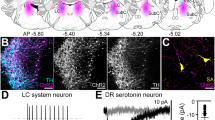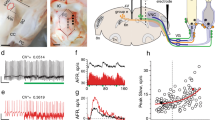Abstract
The dorsal lateral geniculate nucleus (LGNd) receives afferents from the brainstem which regulate its capacity to transmit visual information from the retina to the striate cortex1. One such pathway consists of noradrenaline (NA)-containing fibres originating in the locus coeruleus (LC). These provide a dense, uniform, noradrenergic innervation of the LGNd2. Electrical stimulation in the LC region has been reported to enhance the responsiveness of LGNd neurones to afferent excitation3. Although this effect was abolished when brain NA stores were pharmacologically depleted, it was not established as a direct action of NA on LGNd neurones because of the widespread distribution of LC fibres to many parts of the brain and the long latency of the response. Recently, we observed that NA, applied locally by microiontophoresis with low ejection currents, produced a delayed increase in the firing rate of most spontaneously active LGNd neurones, an effect selectively blocked by α-adrenoceptor antagonists4. We show here that micro-iontophoretic NA can mimic the ability of LC stimulation to enhance the synaptic excitation of LGNd neurones. As neither NA nor LC stimulation activated LGNd neurones in the absence of synaptic or glutamate-induced excitation, both appear to act through a neuromodulatory mechanism. The postsynaptic α-adrenoceptor antagonist WB-41015 blocks the facilitation produced by locally applied NA and by coeruleo-geniculate pathway stimulation, providing evidence for pharmacological identity of the two effects.
This is a preview of subscription content, access via your institution
Access options
Subscribe to this journal
Receive 51 print issues and online access
$199.00 per year
only $3.90 per issue
Buy this article
- Purchase on Springer Link
- Instant access to full article PDF
Prices may be subject to local taxes which are calculated during checkout
Similar content being viewed by others
References
Burke, W. & Cole, A. M. Rev. physiol. biochem. Pharmac. 80, 105–166 (1979).
Kromer, L. F. & Moore, R. Y. Neuroscience 5, 255–271 (1980).
Nakai, Y. & Takaori, S. Brain Res. 71, 47–60 (1974).
Rogawski, M. A. & Aghajanian, G. K. Brain Res. 169, 11–27 (1980).
Kapur, H. & Mottram, D. R. Biochem. Pharmac. 27, 1879–1880 (1978).
Burke, W. & Sefton, A. J. J. Physiol. 187, 201–212 (1966).
Curtis, D. R. & Davis, R. Br. J. Pharmac. 18, 217–246 (1962).
Tebēcis, A. K. & DiMaria, A. Expl Brain Res. 14, 480–493 (1972).
Satinsky, D. Int. J. Neuropharmac. 6, 387–397 (1967).
Fuxe, K. Acta physiol. scand. 64, suppl. 247, 37–85 (1965).
Palkovits, M., Brownstein, M. & Saavedra, J. M. Brain Res. 80, 237–249 (1974).
Freund, H.-J. in Handbook of Sensory Physiology Vol. VII/3B (ed. Jung. R.) 177–246 (Springer, Berlin, 1973).
Bishop, P. O., Burke, W. & Davis, R. J. Physiol. 162, 409–431 (1962).
Sumitomo, I., Nakamura, M. & Iwama, I. Expl Neurol. 51, 110–123 (1976).
Sumitomo, I. & Iwama, I. Jap. J. Physiol. 27, 717–730 (1977).
Sterling, P. & Davis, T. L. J. comp. Neurol. 192, 737–749 (1980).
Lieberman, A. R. Brain Res. 59, 35–59 (1973).
Woodward, D. J., Moises, H. C., Waterhouse, B. D., Hoffer, B. J. & Freedman, R. Fedn Proc. 38, 2109–2116 (1979).
Florey, E. Fedn Proc. 26, 1164–1178 (1967).
Kupferman, I. A. Rev. Neurosci. 2, 447–465 (1979).
Kupferman, I. et al. Fedn Proc. 38, 2095–2102 (1979).
Evans, P. D., Talamo, B. R. & Kravitz, E. A. Brain Res. 90, 340–347 (1976).
Evans, P. D. & O'Shea, M. Nature 270, 257–259 (1977).
Swann, J. W., Sinback, C. N. & Carpenter, D. O. Brain Res. 157, 167–172 (1978).
Berry, M. S. & Pentreath, V. W. J. exp. Biol. 65, 361–380 (1976).
McCall, R. B. & Aghajanian, G. K. Brain Res. 169, 11–27 (1979).
Libet, B. Life Sci. 24, 1043–1058 (1979).
Wood, J. D. & Mayer, C. J. J. Neurophysiol. 42, 582–593 (1979).
Foote, S. L., Freedman, R. & Oliver, A. P. Brain Res. 86, 229–242 (1975).
Segal, M. & Bloom, F. E. Brain Res. 107, 513–525 (1976).
Author information
Authors and Affiliations
Rights and permissions
About this article
Cite this article
Rogawski, M., Aghajanian, G. Modulation of lateral geniculate neurone excitability by noradrenaline microiontophoresis or locus coeruleus stimulation. Nature 287, 731–734 (1980). https://doi.org/10.1038/287731a0
Received:
Accepted:
Issue Date:
DOI: https://doi.org/10.1038/287731a0
This article is cited by
-
Noradrenaline modulates neuronal and perceptual visual detectability via β-adrenergic receptor
Psychopharmacology (2021)
-
Locus coeruleus: a new look at the blue spot
Nature Reviews Neuroscience (2020)
-
Arousal dependent modulation of thalamo-cortical functional interaction
Nature Communications (2018)
-
Methylphenidate Enhances Early-Stage Sensory Processing and Rodent Performance of a Visual Signal Detection Task
Neuropsychopharmacology (2017)
-
Modulatory effects of noradrenaline on the spike activity of cat motor cortex neurons under conditions of skin electrostimulation and action of extra stimuli
Neurophysiology (1994)
Comments
By submitting a comment you agree to abide by our Terms and Community Guidelines. If you find something abusive or that does not comply with our terms or guidelines please flag it as inappropriate.



